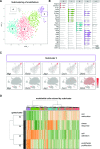A Single-Cell Transcriptome Atlas of the Mouse Glomerulus
- PMID: 29794128
- PMCID: PMC6065081
- DOI: 10.1681/ASN.2018030238
A Single-Cell Transcriptome Atlas of the Mouse Glomerulus
Abstract
Background Three different cell types constitute the glomerular filter: mesangial cells, endothelial cells, and podocytes. However, to what extent cellular heterogeneity exists within healthy glomerular cell populations remains unknown.Methods We used nanodroplet-based highly parallel transcriptional profiling to characterize the cellular content of purified wild-type mouse glomeruli.Results Unsupervised clustering of nearly 13,000 single-cell transcriptomes identified the three known glomerular cell types. We provide a comprehensive online atlas of gene expression in glomerular cells that can be queried and visualized using an interactive and freely available database. Novel marker genes for all glomerular cell types were identified and supported by immunohistochemistry images obtained from the Human Protein Atlas. Subclustering of endothelial cells revealed a subset of endothelium that expressed marker genes related to endothelial proliferation. By comparison, the podocyte population appeared more homogeneous but contained three smaller, previously unknown subpopulations.Conclusions Our study comprehensively characterized gene expression in individual glomerular cells and sets the stage for the dissection of glomerular function at the single-cell level in health and disease.
Keywords: glomerulus; podocyte; scRNAseq; single-cell RNA sequencing; transcriptome.
Copyright © 2018 by the American Society of Nephrology.
Figures




Comment in
- 2036–2038
References
-
- Brinkkoetter PT, Ising C, Benzing T: The role of the podocyte in albumin filtration. Nat Rev Nephrol 9: 328–336, 2013 - PubMed
-
- Neal CR, Muston PR, Njegovan D, Verrill R, Harper SJ, Deen WM, et al. .: Glomerular filtration into the subpodocyte space is highly restricted under physiological perfusion conditions. Am J Physiol Renal Physiol 293: F1787–F1798, 2007 - PubMed
Publication types
MeSH terms
LinkOut - more resources
Full Text Sources
Other Literature Sources
Molecular Biology Databases

